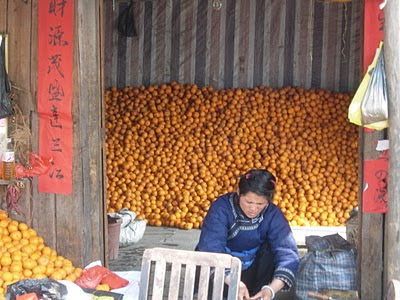We were delighted to wake up in the morning to the serenity
around
Ronjiang Hotel. The hotel was secluded as it was located far from the main road and and surrounded by a private garden. Nevertheless, we discovered a different world outside the hotel when we walked to the main road after our breakfast. The streets were bustling with people and activities!
 |
Middle - Appetizing "Jiaozi"
Right - The people here had sweet tooth |
Although the steaming food seems pretty appetizing to us, we could only share a bowl of red bean soup as we were still full from the heavy breakfast. We spotted a hair salon on the main street and decided that we could have a good hair wash.....
 |
| Cool ladies! With a twist, one can turn to be a new fashion icon in the city. |
 |
| Yummy! |
 |
| Mandarin oranges |
The market was just within walking distance from our hotel. Our driver were waiting at the hotel while we explored the market. It was fascinating to see the locals in their traditional clothing, hairstyles and speaking the local dialects which we didn't understand at all. We find pleasure in sampling the local snack and even bought some fresh vegetables that were later being cooked at the restaurant for lunch. We appeared to be the only tourists in this area and as we observed the locals, , we were being observed too.
 |
| Typical octagonal pagoda type drum tower located a the centre of Xiajiang Dong village. |
 |
Dong girls
|
Without further delayed, we continue our journey to the southeast of
Ronjiang. We drove passed beautiful landscapes and people along the way. After two hours of driving along the country sites, we reached the next highlight of our day - a visit to a
Dong village, located 20km north of the county town
Congjiang.
Yingtan Dong village has existed since
Qing Dynasty. It has a population of 1,700 people.
According to the latest statistic, the total population of Dong people is 2,960,293. They are mainly distributed in the mountainous areas between the four provinces of
Guizhou, Hunan, Guangxi and
Hubei. The major residences for the
Dongs are
Southeastern Guizhou where
Yingtan Dong village is located. They
Dongs are known for their architecture, particularly their octagonal pagoda-type
drum towers , wind and rain bridges that provide sheltering for people during bad weathers. The drum towers of
Dongs were built without a single nail. They are the symbol of
Dongs and served as a gathering place for the villages to discuss and settle important matters, hold important festivals or entertainments.
 |
| Warping the loom |
The weather was getting warm and sunny in March 2008. It was a good time to carry on with various outdoor activities. We were thrilled to find many
Dong ladies working together in village for the various processes of cloth making. Some were busy spinning; 2 groups of ladies warping the looms which were extended as far as 70 feet from one end to another. The ladies were quite and attentive to their work as
Dongs have taboos on speech during the weaving. For instance, they cannot use terms such as ‘broken’ and ‘disorder’, which they believe may cause the weaving to fail. ‘disorder’, which they believe may cause the weaving to fail. We felt that we have traveled back in time just by walking around the village. We were the two aliens who didn't fit in the picturesque scene. Although they are now connected to the modern world with infrastructures development, the people here remain to be living in their secluded world, except from the few antennas that stand out like sore thumbs.
 |
| Dong hand woven fabric. Close-up on the pattern. |
We visited the only grocery store in the village and bought a roll of plain hand-woven textiles. This woven fabric would be dyed if I have not taken it under my possession. Though many of the minority
tribes use indigo plant to make their dyes, each tribe put their signature by adding different ingredients to the indigo dyes. The Dong women add lime water to indigo plants to make their dyestuff. The fabric went through repeated processes of dyes and washes up to three or four times before the color is deemed to be perfect. Next, persimmon peels and chestnut shells are pounded into liquid and mix with a kind of berry-Ardisia crenata. Again the cloth goes through another dying process to achieve a deep blue with radiant rosy accents. After drying, the cloth will be folded, coated with egg white and intermittently beaten with a wood mallet over the course of two weeks until the cloth shines. The final step is to starch the cloth with glue made from cattle skin, this process ensures durability and fade -resistant to the fabric. The brightness of the cloth varies, depending upon the duration of crafting and beating. The more it shines, the more precious the cloth is deemed to be.
Another interesting and environment friendly culture of Dong is that whenever a girl is born, her parents would plant tens up to hundred of fir saplings for their baby. When the child reaches the age of 18 and marries, the fir trees, that have matured too, are felled and used to build houses for the bride and groom or for sale. For this reason, such fir trees are called "18-year-trees." So, it is no surprise to see many fir trees growing around the Dongs' villages.











